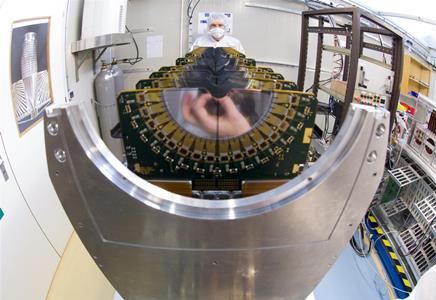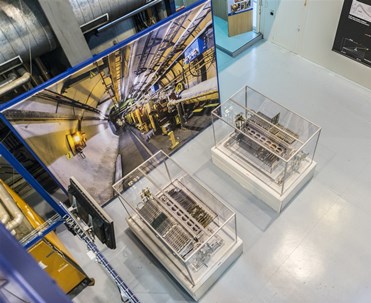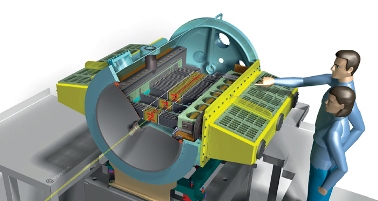At LHCb the protons collide inside the VErtex LOcator detector (VELO). The VELO is composed of two halves, each consisting of 21 pairs of back-to-back silicon sensors, whose job is to precisely measure the position at which the charged particles pass (see left image below). You can watch the sophisticated construction process at the video here and can read more details about this detector here. Its sensitive detector elements are held out of harm’s way while the beams are being injected and stabilized, but once safer, the silicon elements are moved mechanically in towards the beam to hunt for beauty and charm particles.
The LHCb VELO detector plays an essential role in locating precisely the pp collision point as well as the location of beauty and charm particle decays, see, for example, 12 March 2013 news. This detector is so important that the LHCb Collaboration decided to build a second identical Vertex Locator in order to replace the one located around beam should this ever be needed. Since the primary VELO detector is still working perfectly the replacement version is now displayed at the LHCb surface exhibition as seen in the right image below.
The LHCb Collaboration is working towards a major upgrade of the LHCb experiment for the restart of data-taking in 2019. Most of the subdetectors and electronics will be replaced so that the experiment can read out collision events at the full rate of 40 MHz. The upgrade will also allow LHCb to run at higher luminosity and eventually accumulate an order of magnitude more data than was foreseen with the current set-up.
The VELO performance will also be strongly improved. Pixel technology will be used to buid this third version of the detector. The new detector will contain 40 million pixels, each measuring 55 μm square. The pixels will form 26 planes arranged perpendicularly to the LHC beams over a length of 1 m (see image). The sensors will come so close to the interaction region that the LHC beams will have to thread their way through an aperture of only 3.5 mm radius.
Read more in CERN Courier article and in the LHCb VELO Upgrade Technical Design Report.
click the images for higher resolution



